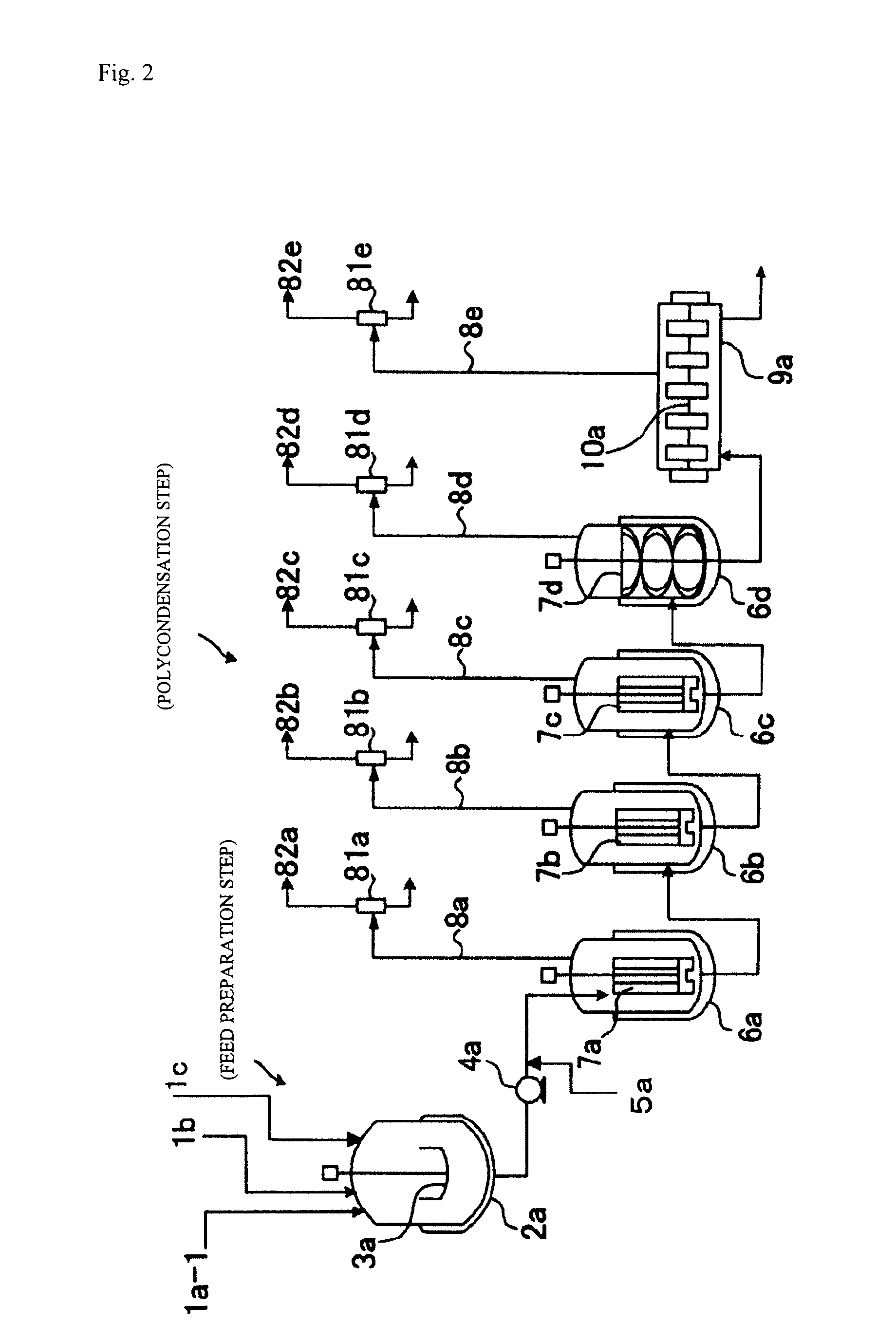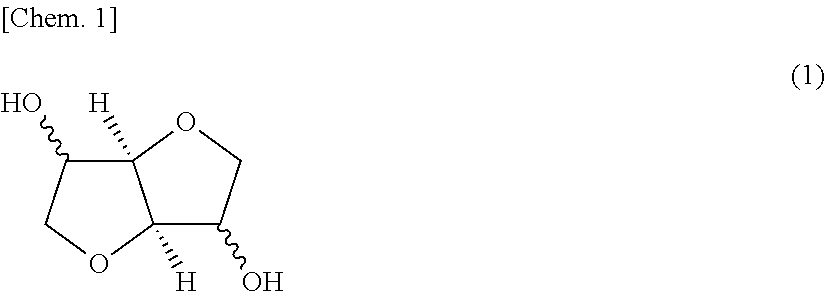Processes for producing polycarbonate
a polycarbonate and process technology, applied in the field of polycarbonate, can solve the problems of inability to meet the requirements of aromatic polycarbonates, inferior reactivity of polycarbonates having such a structure on the one hand, and fear of oil resource depletion, and achieve the effects of reducing coloration, high thermal stability, and stably and efficiently producing
- Summary
- Abstract
- Description
- Claims
- Application Information
AI Technical Summary
Benefits of technology
Problems solved by technology
Method used
Image
Examples
example 1
[0386]As shown in FIG. 1, which was described hereinabove, a polycarbonate was produced with the continuous production apparatus including four vertical stirring reactors and one horizontal stirring reactor under the following conditions.
[0387]First, as shown below, the reactors and preheaters each were set beforehand so as to have the internal temperature and pressure shown in Table 1 according to the reaction conditions. In Table 1, “Temperature difference” means the difference between the polymer temperature in each polymerizer and the temperature of the heating medium being supplied to the polymerizer.
[0388]Next, in a separate starting-material preparation step, the isosorbide (ISOB) purified by distillation as described above, tricyclodecanedimethanol (TCDDM), and diphenyl carbonate (DPC) were mixed together in a given molar ratio (DPC / ISOB / TCDDM=1.03 / 0.7 / 0.3) and heated to 140° C., in a nitrogen gas atmosphere. Thus, a starting-material molten mixture was obtained.
[0389]Subseq...
example 2
[0394]Polymerization reaction was conducted in the same manner as in Example 1, except that the conditions for the first vertical stirring reactor 6a, fourth vertical stirring reactor 6d, and fifth horizontal stirring reactor 9e were changed as shown in Table 1. The polycarbonate obtained had a reduced viscosity of 0.56, a glass transition temperature (Tig) of 129° C., a color b value of 5.0, a formic acid content lower than 2 ppm by weight, a terminal phenyl group concentration of 95 μeq / g, an isosorbide-derived terminal double-bond content of 3.0 μeq / g, a phenol content of 50 ppm by weight, and a 5% weight loss temperature of 350° C. These results are summarized in Table 1. The polycarbonate further had the same values of photoelastic coefficient, d-line refractive index, and Abbe number as in Example 1.
example 3
[0395]Polymerization reaction was conducted in the same manner as in Example 1, except that the preheater 11a was not used and the conditions for the first vertical stirring reactor 6a, fourth vertical stirring reactor 6d, and fifth horizontal stirring reactor 9e were changed as shown in Table 1. The polycarbonate obtained had a reduced viscosity of 0.56, a glass transition temperature (Tig) of 129° C., a color b value of 6.7, a formic acid content of 4 ppm by weight, a terminal phenyl group concentration of 45 μeq / g, an isosorbide-derived terminal double-bond content of 8.5 μeq / g, a phenol content of 72 ppm by weight, and a 5% weight loss temperature of 345° C. These results are summarized in Table 1. The polycarbonate further had the same values of photoelastic coefficient, d-line refractive index, and Abbe number as in Example 1.
PUM
| Property | Measurement | Unit |
|---|---|---|
| temperature | aaaaa | aaaaa |
| temperature | aaaaa | aaaaa |
| temperature | aaaaa | aaaaa |
Abstract
Description
Claims
Application Information
 Login to View More
Login to View More - R&D
- Intellectual Property
- Life Sciences
- Materials
- Tech Scout
- Unparalleled Data Quality
- Higher Quality Content
- 60% Fewer Hallucinations
Browse by: Latest US Patents, China's latest patents, Technical Efficacy Thesaurus, Application Domain, Technology Topic, Popular Technical Reports.
© 2025 PatSnap. All rights reserved.Legal|Privacy policy|Modern Slavery Act Transparency Statement|Sitemap|About US| Contact US: help@patsnap.com



